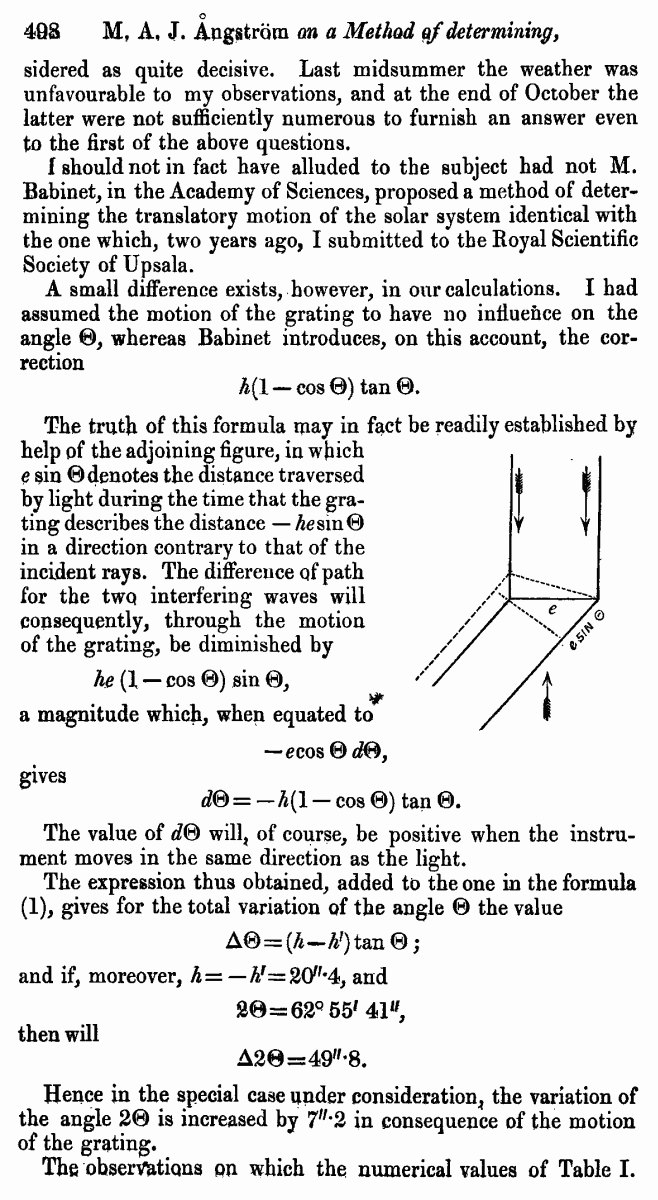

III.
In a lecture given on October 6, 1860, to the Royal Scientific Society of Upsala, I explained a method of determining the motion of the solar system by observations on the interfer-ence-bands of a glass grating. I then showed that if we assume the propagation of the undiffracted rays, passing through the openings of the grating, to be uninfluenced by the motion of the instrument, the same must be true of the formation of the interference-bands on both sides; consequently, also, that when a telescope' is used in the observations the customary aberration must ensue, and be proportional to the ratio between the motion of the telescope, in a direction perpendicular to its axis, and the velocity of light along this axis.
Hence, the velocity of light being taken as the unit, if h be the velocity of the instrument in the direction of the incident light, then for an angle й, under which, e. g., the D line in an interference-spectrum is observed, the velocity of the telescope perpendicular to this direction will be
h sin йj
which accordingly must be the expression for the aberration.
If the angle й were observed for two positions of the instrument in which the velocities in the path of the incident rays were h and hi, we should then have
Aй = (A Ч h!) sin й,.....(1)
or, since 20 is the angle immediately given by observation,
A.2й=2(hЧh1) sinй.
Putting h{= Чhr) equal to the velocity of the earth in its orbit, this equation gives
A.2й = 81"-6sin@;
and since, for the double line D in the fourth spectrum,
2й=62░ 55' 44"-2,
we deduce
A.2A=42"-6,
a magnitude capable of being readily observed.
Two questions have here to be answered by observation. The one has reference to the actual existence of the phenomenon, and may be most readily answered by applying the method to the known orbital motion of the earth; the other has reference to the employment of the method, when proved to be accurate, to the determination of the translatory motion of the solar system.
The experiments hitherto made cannot in any respect be con
sidered as quite decisive. Last midsummer the weather was unfavourable to my observations, and at the end of October the latter were not sufficiently numerous to furnish an answer even to the first of the above questions.
f should not in fact have alluded to the subject had not M. Babinet, in the Academy of Sciences, proposed a method of determining the translatory motion of the solar system identical with the one which, two years ago, I submitted to the Royal Scientific Society of Upsala.
A small difference exists, however, in our calculations. I had assumed the motion of the grating to have no influence on the angle й, whereas Babinet introduces, on this account, the correction
A (I Ч cos @) tan й.
The truth of this formula may in fact be readily established by help of the adjoining figure, in which e sin йdenotes the distance traversed by light during the time that the grating describes the distance Ч Aesinй in a direction contrary to that of the incident rays. The difference of path for the two interfering waves will consequently, through the motion of the grating, be diminished by
he (1 Ч cos й) sin й, a magnitude which, when equated to Чecosй<2й,
gives
dо= Ч A(l Ч cos й) tan й.
The value of dо will, of course, be positive when the instrument moves in the same direction as the light.
The expression thus obtained, added to the one in the formula (1), gives for the total variation of the angle й the value
Aй=(AЧ#)tan й; and if, moreover, h= Ч A,= 20",4, and
80=62░ 55'41",
then will
A20=49"-8.
Hence in the special case under consideration, the variation of the angle 2й is increased by 7"С2 in consequence of the motion of the grating.
The observations pn which the numerical values of Table I.